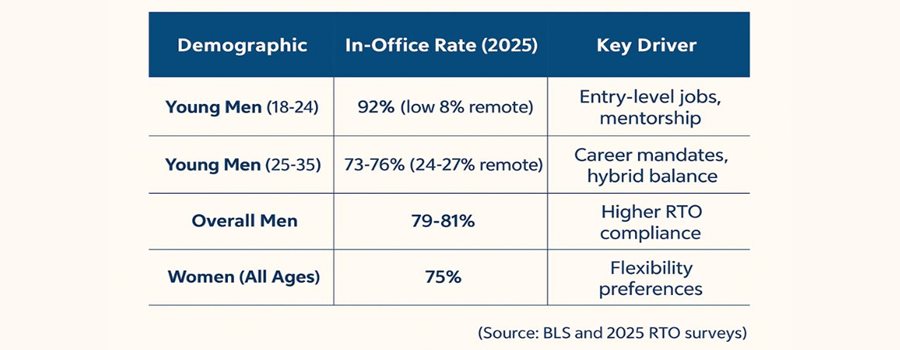The tug of war between remote and the classic office work model has shifted decisively, at least for one key demographic: young men. After decades of declining labor force participation—a decline driven by stagnant wages, health crises, and skill mismatches—men aged 18 to 35 are re-entering office buildings in notable numbers (Pew Research Center, 2023). And in 2025, young men are clearly leading the return-to-work surge.
By mid-2025, trends suggest young men in office-based roles will be back on site in force—either in a hybrid rhythm or full-time presence. While this trend varies by industry, it signals a demographic hungry for the pay, growth, and in-person opportunities an office environment offers. For property managers overseeing corporate spaces, this is a moment to pay close attention to whose footsteps are echoing through your lobby.
Understanding these shifting rhythms can help you tailor messaging, curate high-impact amenities, and ultimately boost tenant retention. Below, we unpack the data, share specific tactics for gathering tenant input, and offer concrete ideas to align your spaces with what young men are actually looking for as they navigate their return to work.
Why Are Young Men Leading the Return to Work Surge?
A long road back. The pandemic accelerated remote work, but it wasn’t equally embraced across demographics. Young men, especially those with bachelor’s degrees, have been steadily increasing their labor market participation post-2020. For 18- to 35-year-olds in office-based roles, participation rose from 60.4 percent in 2023 to 61.2 percent in 2024, with projections hitting 70 percent by mid-2025 (BLS, 2024).
Mandates and mindsets. Powerhouse employers in tech and finance (Google, Goldman Sachs, Apple) have ramped up return-to-office requirements. Young men, more concentrated in these sectors, are responding in kind. This mix of career aspirations, in-person collaboration benefits, and employer mandates is driving the surge back to desks and meeting rooms.
What Does Young Men Returning to Work Means for Property Managers
Seeing more suits and jeans through your turnstiles doesn’t automatically translate into happier tenants. Property managers must treat this as more than a desk-chair-home shuffle; it’s an invitation to rethink what an office building delivers beyond square footage.

Occupancy isn’t uniform
Even with a projected high percent return rate, usage patterns will differ. Monday mornings might be bustling, but Friday afternoons still trend toward empty seats. Track entry swipe data and, better yet, ask tenants directly, so you know when lobbies feel full and when they don’t.
What Ammenities Matter to Young Men?
Young men often cite career growth, in-person collaboration, and personal branding as prime motivators for showing up. You’ll win loyalty by extending value beyond conference rooms. Would a wellness kiosk resonate more than a noisy game zone? Could podcast-recording booths with quality lighting attract tenants? Or might micro-networking hubs foster the professional connections they crave?
How to Gather Real Insights: Qualitative Polls
Numbers tell you what but not why. To refine your offerings, embed short qualitative polls in monthly newsletters or via your tenant portal:
-
Keep it bite-sized. Ask two open-ended questions: “Which three amenities make your day easier?” and “What’s one thing you’d add to your ideal workday lobby experience?”
-
Use A/B prompts. Offer two contrasting visions, say, a wellness lounge versus a podcast booth—and let tenants weigh in with their thoughts or actions.
-
Incentivize feedback. A coffee-bar gift card raffle can drive responses from time-pressed professionals.
-
Share results transparently. In your next communication, summarize top suggestions and outline “Next Steps” to build trust and encourage ongoing participation.
Over time, these touchpoints do more than guide investment. They reinforce a sense of community ownership, showing tenants that your building evolves with their needs.
Amenity Ideas That Resonate With Young Men
Based on early polls and anecdotal feedback, here are three high-impact concepts:
-
Micro-Networking Hubs
Modular “focus pods” with writable walls and phone-booth acoustics. Perfect for 10-minute brainstorms or quick client calls.
-
Technology-Driven Wellness
Digital kiosks offering posture checks, eye-strain timers, or desk-stretch routines. A small wellness room with biofeedback stations taps into health benefits as an example.
-
Content Creation Corners
Mini studios with ring lights, green screens, and basic editing software. Ideal for pitching investors or recording podcasts—appealing to a generation that creates as much as it collaborates.
Start small: pilot one concept on a single floor for a month, track usage, then expand what works.
Practical Next Steps
-
Analyze your data. Chart occupancy against amenity usage and poll responses.
-
Set a budget. Allocate 1–2 percent of annual operating expenses for amenity experiments.
-
Communicate constantly. Market each new feature with a tenant spotlight: “See how Alex closed a deal in our Micro-Networking Hub.”
Turning Insights into Action
Young men, driven by career ambitions, in-person collaboration, and employer mandates, are leading the return-to-office movement. By blending hard data with the human stories behind it, property managers can create spaces people want to work from—particularly young men.
Don't know how to use these insight?